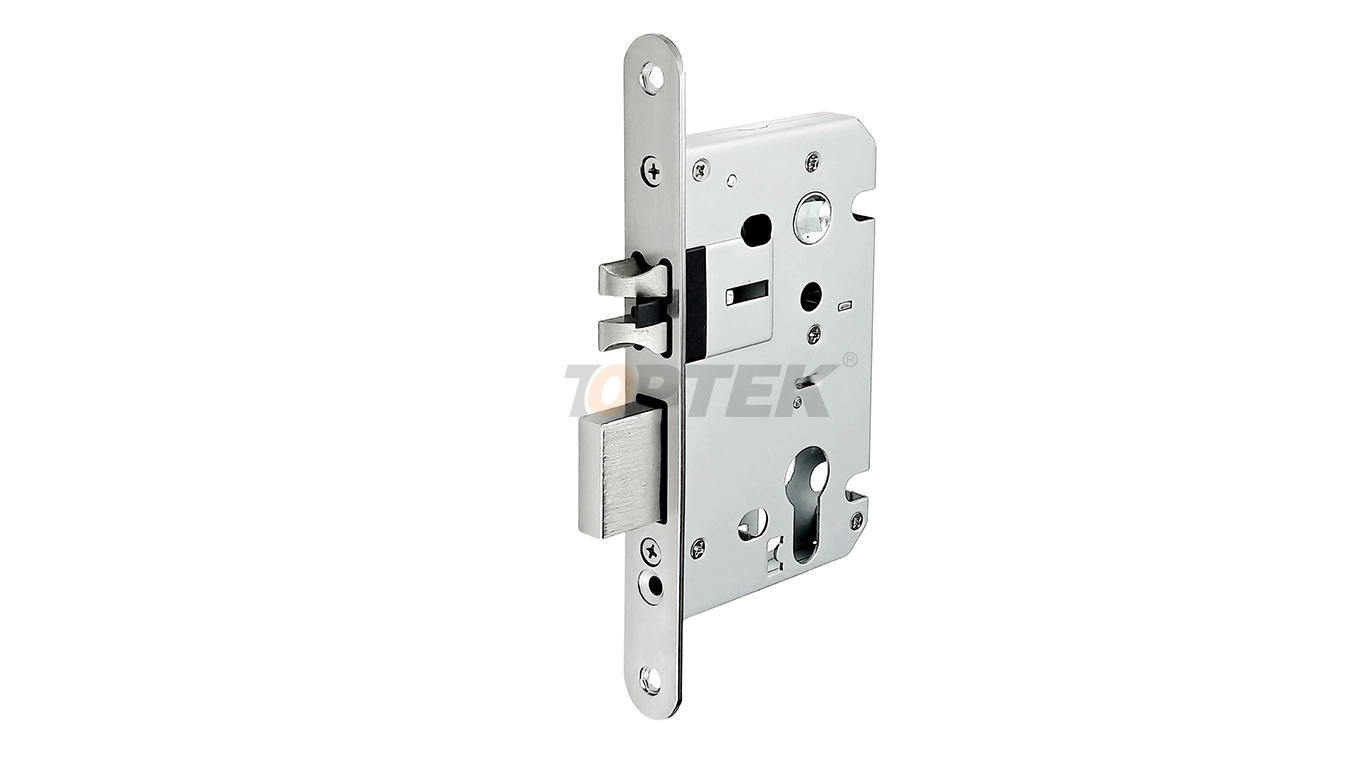Installing a bathroom mortice lock might seem intimidating, but with the right tools and step-by-step guidance, it's a manageable DIY project that can enhance your bathroom's privacy and security. Unlike surface-mounted locks, a mortice lock sits within the door itself, providing a clean, professional appearance and superior durability.
Whether you're replacing an old lock or installing one for the first time, this comprehensive guide will walk you through the entire process. You'll learn what tools you need, how to measure accurately, and the exact steps to achieve a professional-looking installation.
What Is a Bathroom Mortice Lock?
A bathroom mortice lock is a specialized locking mechanism designed specifically for bathroom doors. It's installed within a rectangular cavity (called a mortice) cut into the edge of the door, rather than being mounted on the surface.
The key components include:
· Lock body: The main mechanism that sits inside the door
· Faceplate: The visible metal plate on the door edge
· Handle spindle: The square rod that connects both door handles
· Thumbturn or emergency release: Allows unlocking from outside in emergencies
Bathroom mortice locks differ from standard door locks because they typically feature a thumbturn mechanism on the inside and an emergency release on the outside, making them ideal for privacy while ensuring safety.
Tools and Materials You'll Need
Before starting your installation, gather these essential tools:
Tools:
· Chisel set (½-inch and 1-inch widths work best)
· Mallet or hammer
· Drill with bits (including a 25mm spade bit)
· Pencil for marking
· ape measure
· Spirit level
· Screwdriver set
· Sharp knife or marking gauge
Materials:
· Bathroom mortice lock
· Wood screws (usually included with the lock)
· Wood glue (optional, for any repairs)
· Sandpaper (120-grit)
Measuring and Marking Your Door
Accurate measurements are crucial for a successful installation. Start by determining the correct height for your lock.
Standard measurements:
· Lock height: 36-42 inches from the floor (align with existing door handles if possible)
· Backset: Usually 2¼ inches from the door edge (check your lock specifications)
Mark the center line on both faces of the door at your chosen height. Use a spirit level to ensure your marks are perfectly aligned. Next, mark the door edge where the lock body will sit, typically 2¼ inches from the door face.
Double-check all measurements before proceeding. Remember the old carpenter's rule: measure twice, cut once.
Creating the Mortice Cavity
This step requires patience and precision. The mortice cavity must be exactly the right size for your lock body.
Step 1: Mark the outline
Place your lock body against the door edge at your marked height. Trace around it with a pencil, creating a clear outline of the required cavity.
Step 2: Drill the initial holes
Using a drill bit slightly smaller than your lock body width, drill several holes within your marked outline. This removes most of the waste material and makes chiseling easier.
Step 3: Chisel the cavity
Start with a sharp chisel that's slightly narrower than your cavity width. Work gradually, removing small amounts of wood at a time. Keep checking the fit with your lock body—it should sit flush with the door edge when properly fitted.
Step 4: Test the fit
Your lock should slide smoothly into the cavity without forcing. If it's too tight, carefully remove more material with your chisel. If it's too loose, you may need wood filler or thin wooden shims.
Drilling Handle and Key Holes
The spindle hole connects both sides of the door and must be perfectly aligned.
Drilling the spindle hole:
Measure the distance from the door edge to the spindle center (usually marked on your lock). Mark this point on both door faces. Use a 25mm spade bit to drill from one side, stopping when the pilot point just emerges on the other side. Complete the hole by drilling from the opposite side—this prevents splintering.
Creating the keyhole:
If your lock includes an external key cylinder, drill the appropriate sized hole according to the manufacturer's specifications. This is typically smaller than the spindle hole and may require a stepped drilling process.

Installing the Lock Mechanism
With your cavities and holes prepared, you can now install the lock components.
Step 1: Insert the lock body
Slide the lock body into its mortice cavity. It should sit flush with the door edge. If the faceplate protrudes, you'll need to create a shallow recess for it.
Step 2: Mark and cut the faceplate recess
Trace around the faceplate with a sharp knife. Use your chisel to create a shallow recess—typically 2-3mm deep—so the faceplate sits flush with the door edge.
Step 3: Secure the lock
Once the lock body fits perfectly, secure it with the provided screws. Ensure it doesn't move within the cavity before fully tightening.
Fitting Handles and Hardware
The final step involves installing the visible components that you'll interact with daily.
Installing handles:
Thread the spindle through the lock mechanism and both door faces. Attach the handles according to the manufacturer's instructions, ensuring they operate smoothly and align properly.
Testing the thumbturn:
The internal thumbturn should rotate easily and engage the lock mechanism with a clear clicking sound. If it feels stiff or doesn't engage properly, check that all components are correctly aligned.
Emergency release setup:
Test the external emergency release mechanism. This should allow the door to be unlocked from outside in case someone becomes trapped inside the bathroom.
Common Installation Mistakes to Avoid
Even experienced DIYers can make errors when fitting a bathroom mortice lock. Here are the most common pitfalls:
Incorrect measurements: Always verify your measurements against the lock specifications before cutting. Different manufacturers may have slightly different dimensions.
Rushing the chiseling: Take your time creating the mortice cavity. It's easier to remove more material than to repair an oversized hole.
Misaligned holes: Ensure your spindle hole is perfectly perpendicular to the door faces. A slight angle will cause binding and premature wear.
Ignoring door thickness: Confirm your door is thick enough for your chosen lock. Standard bathroom doors should accommodate most mortice locks, but older or thinner doors may require special consideration.
Testing and Final Adjustments
Before considering the job complete, thoroughly test your installation.
Check that the door opens and closes smoothly without binding. The lock should engage and disengage easily from both sides. Test the emergency release function to ensure it works correctly.
If you notice any stiffness or alignment issues, make small adjustments now rather than living with a subpar installation.
When to Call a Professional
While fitting a bathroom mortice lock is within most DIYers' capabilities, certain situations warrant professional help:
· Doors with unusual thickness or construction
· Glass or composite doors requiring specialized techniques
· Situations where you're uncomfortable using chisels or power tools
· When building regulations or warranty requirements specify professional installation
Maintaining Your New Lock
A properly installed bathroom mortice lock should provide years of reliable service with minimal maintenance. Periodically lubricate the mechanism with a light machine oil, and keep the spindle hole clear of debris.
If you notice the lock becoming stiff or difficult to operate, check for paint buildup around the faceplate or debris in the mechanism before assuming the lock is faulty.
Your newly installed bathroom mortice lock will provide enhanced privacy and security while maintaining the clean, professional appearance that makes mortice locks so popular. With proper installation and care, it should serve your household well for many years to come.
Bathroom Mortice Lock
Mortice Lock
CE Mortice Lock
English
العربية
Français
Русский
Español
Português
Deutsch
italiano
日本語
한국어
Nederlands
Tiếng Việt
ไทย
Polski
Türkçe
አማርኛ
ພາສາລາວ
ភាសាខ្មែរ
Bahasa Melayu
ဗမာစာ
தமிழ்
Filipino
Bahasa Indonesia
magyar
Română
Čeština
Монгол
қазақ
Српски
हिन्दी
فارسی
Kiswahili
Slovenčina
Slovenščina
Norsk
Svenska
українська
Ελληνικά
Suomi
Հայերեն
עברית
Latine
Dansk
اردو
Shqip
বাংলা
Hrvatski
Afrikaans
Gaeilge
Eesti keel
Māori
සිංහල
नेपाली
Oʻzbekcha
latviešu
অসমীয়া
Aymara
Azərbaycan dili
Bamanankan
Euskara
Беларуская мова
भोजपुरी
Bosanski
Български
Català
Cebuano
Corsu
ދިވެހި
डोग्रिड ने दी
Esperanto
Eʋegbe
Frysk
Galego
ქართული
guarani
ગુજરાતી
Kreyòl ayisyen
Hausa
ʻŌlelo Hawaiʻi
Hmoob
íslenska
Igbo
Ilocano
Basa Jawa
ಕನ್ನಡ
Kinyarwanda
गोंगेन हें नांव
Krio we dɛn kɔl Krio
Kurdî
Kurdî
Кыргызча
Lingala
Lietuvių
Oluganda
Lëtzebuergesch
Македонски
मैथिली
Malagasy
മലയാളം
Malti
मराठी
ꯃꯦꯇꯥꯏ (ꯃꯅꯤꯄꯨꯔꯤ) ꯴.
Mizo tawng
Chichewa
ଓଡ଼ିଆ
Afaan Oromoo
پښتو
ਪੰਜਾਬੀ
Runasimi
Gagana Samoa
संस्कृत
Gaelo Albannach
Sepeti
Sesotho
chiShona
سنڌي
Soomaali
Basa Sunda
Wikang Tagalog
Тоҷикӣ
Татарча
తెలుగు
ትግንያውያን
Xitsonga
Türkmençe
संस्कृत
ئۇيغۇرچە
Cymraeg
isiXhosa
ייִדיש
Yorùbá
isiZulu


































